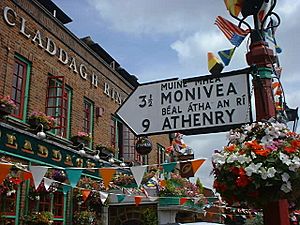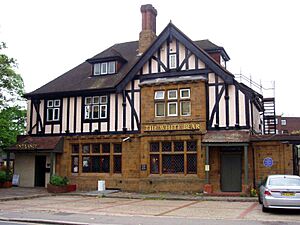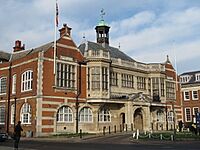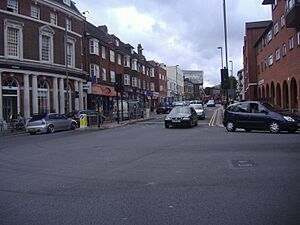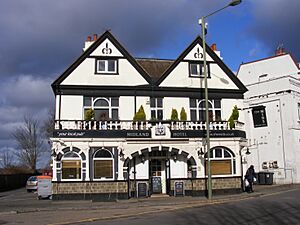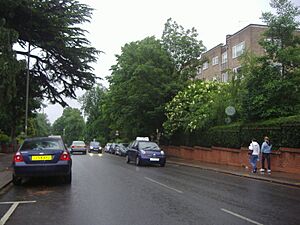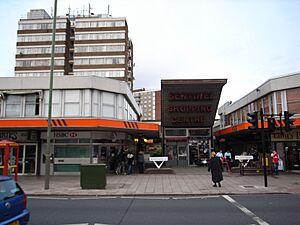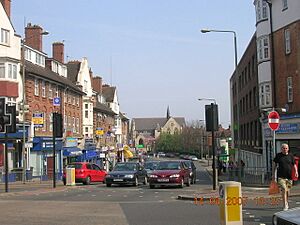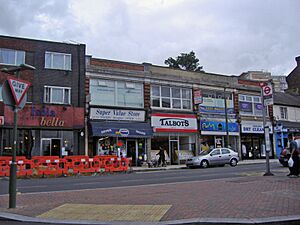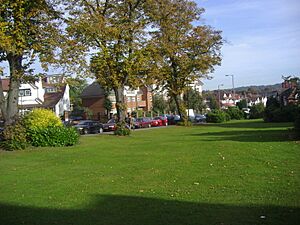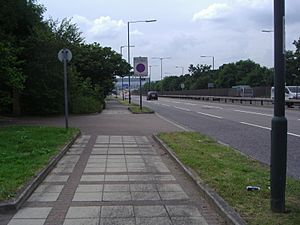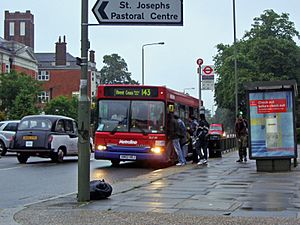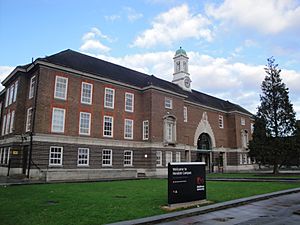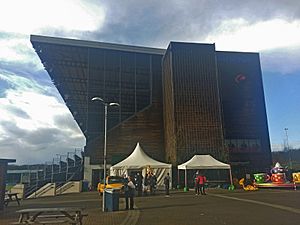Hendon facts for kids
Quick facts for kids Hendon |
|
|---|---|
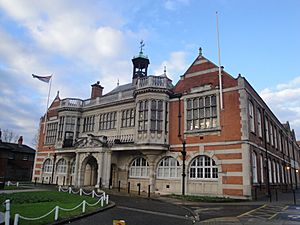 Hendon Town Hall |
|
| Population | 35,874 (2011 Census) |
| OS grid reference | TQ229887 |
| London borough | |
| Ceremonial county | Greater London |
| Region | |
| Country | England |
| Sovereign state | United Kingdom |
| Post town | LONDON |
| Postcode district | NW4,NW9 |
| Dialling code | 020 |
| Police | Metropolitan |
| Fire | London |
| Ambulance | London |
| EU Parliament | London |
| UK Parliament |
|
| London Assembly |
|
Hendon is a busy area in northwest London, located in the London Borough of Barnet. It's about 7 miles (11 km) northwest of Charing Cross, a famous spot in central London. Hendon used to be an old manor (a large estate) and a parish (a local church area) in the county of Middlesex. It was also a former borough (a self-governing town area) called the Municipal Borough of Hendon. Since 1965, Hendon has been part of Greater London. Most of Hendon is in the NW4 postcode area, while the West Hendon part is in NW9. Colindale to the northwest was once part of Hendon but is now separated by the M1 motorway.
Hendon is well-known for its history with flying. It was home to the London Aerodrome, which later became RAF Hendon, a Royal Air Force base. From 1972, parts of the RAF station were used for new homes and the RAF Museum. Trains arrived in Hendon in 1868 with Hendon station on the Midland Main Line. The London Underground came later in 1923, with Hendon Central. By the 1890s, Brent Street became the main shopping area.
Hendon is easy to reach by several main roads, including the A41, A406 (North Circular), the A1, and the M1 motorway. Today, Hendon is home to the rugby club Saracens F.C., who play at Copthall. It's also where Middlesex University is located. The area is represented in parliament by its own constituency, also called Hendon, which includes Edgware and Mill Hill.
Contents
Exploring Hendon's Past
The name Hendon means "the high place" or "down" (like a rolling hill). Hendon's motto is Endeavour, which means to try hard. Hendon was a civil parish in the old "hundred of Gore" in Middlesex. The area was mentioned in the Domesday Book in 1087, but the name 'Hendun' is even older. People have found signs of Roman settlements here.
The Midland Railway and Great Northern Railways were built through Hendon in the 1860s. The underground train system (Northern line) reached Golders Green to the south in 1907. The line was then extended to Hendon Central, Colindale, and Edgware in 1923–24.
Much of Hendon grew into a London suburb. Today, it's mostly built-up, but there are still some green areas, especially around Mill Hill, like the Copthall playing fields. Hendon's main industries from the 1880s were manufacturing, including motor and aviation factories. In 1931, the area of Edgware was added to Hendon, making it much larger. This meant Hendon stretched from Edgware and Mill Hill down to Golders Green, Childs Hill, and Hampstead Garden Suburb.
Hendon became an urban district in 1894. In 1932, it became the Municipal Borough of Hendon. This borough was removed in 1965, and Hendon became part of the London Borough of Barnet.
Hendon is famous for its role in the early days of flying. The Hendon Aerodrome is now the RAF Museum. The area is strongly linked to the aviation pioneer Claude Grahame-White. Another part of the old Aerodrome site is the Hendon Police College, where Metropolitan Police officers are trained.
In 1976, the Brent Cross Shopping Centre was built and opened at the southern end of Hendon, near the North Circular Road.
Church End: A Glimpse into History
The Hendon and District Archaeological Society has found Roman items at Church End. The Saxon settlement near St Mary's Church might not be directly connected to the Roman one. A priest was mentioned in the Domesday Book, and a church building was recorded in 1157. The oldest parts of the current church are from the 13th century. The 50-foot (15 m) tower (around 1450) was repaired in the 18th century.
Sir Stamford Raffles, who founded Singapore in 1819, is buried in the churchyard. Another notable person buried here is football manager Herbert Chapman, who managed famous clubs like Arsenal.
Next to the church is the Greyhound pub, rebuilt in 1898. It was originally called the Church House and was used for local meetings. In 1676, the inn, then known as the Greyhound, burned down.
Further west, near the Greyhound pub, is the oldest building in Hendon. It's a 17th-century farmhouse that used to be the Church Farmhouse Museum (1955–2011). Now, it's part of the Middlesex University campus.
The Claddagh Ring pub, originally The Midland Arms, is in Church Road. Its Irish sign is popular with the large Irish community in the area. The Irish connection to Hendon dates back to the early 19th century, when many Irish people came here to work in haymaking, which Hendon was known for.
The Burroughs: A Historic Hamlet
The Burroughs was a separate small village until the 1890s. Its name likely refers to areas where rabbits were kept.
There was an inn and brewery here by the 16th century, possibly the White Bear, which was rebuilt in 1932. This inn hosted "leet courts," which were old feudal meetings to manage the area.
By 1697, the inn was the site of Hendon's Whitsun fair. This fair was originally for hiring hay farmers and was known for dancing and country sports.
From 1735 until 1934, a building that housed older local people stood where Quadrant Close is now. These were sometimes mistakenly called 'alms-houses'.
During this time, three religious places were built. A Methodist chapel opened in 1827. A Roman Catholic chapel, later called Our Lady of Dolours, opened in 1863. The modern Methodist chapel was built in 1937.
Grove House, built before 1753, was a private hospital by 1900. It was taken down in 1933. The remaining land became a public park. Several old 18th and 19th-century houses still stand. The Poor Handmaids of Jesus Christ started the Convent of St Joseph in 1882, adding a school by 1900.

Hendon Town Hall was built in 1900.
Hendon's first proper fire station (1914) was built next to the town hall. Hendon Library, built in 1929, is also next to the town hall. Eileen Colwell, a famous children's librarian, worked at Hendon for many years from the 1930s.
Between 1937 and 1939, the Middlesex County Council built 'Hendon Technical Institute'. This later became 'Hendon College', then 'Hendon Polytechnic' in 1973, and is now part of Middlesex University.
The Hendon War Memorial was revealed on St George's Day, April 23, 1922. It was moved to its current spot in 1962.
West Hendon and The Hyde: Along the Old Roman Road
West Hendon Broadway is part of the main A5 road (or Edgware Road), which was the Roman road Watling Street. In the 18th century, two pubs called "Welsh Harp" were built, giving the popular nickname to the nearby Brent Reservoir. Hendon railway station opened in 1868, followed by Welsh Harp railway station, built by the Midland Railway. This new area around the A5 and Hendon rail station became known as New Hendon by the 1880s. West Hendon Broadway was served by electric trams from 1904. This area became a popular shopping district.
To the north, The Hyde was home to Hendon's courthouse, which opened in 1913. An outdoor swimming pool was built here by 1922. In 1925, Duple Coachbuilders opened a factory here, employing 800 workers. This factory closed in 1970.
Parson Street and Holders Hill: Grand Houses and Schools
In the 18th century, some land around Hendon Place was sold for large houses. Hendon Hall (built in 1756) was one of the last and best-known of these grand homes. A small monument in the hotel garden, dedicated to William Shakespeare and David Garrick, used to stand in Manor Hall Road.
On Parson Street, St Swithans was a convent and training house for the Sisters of Nazareth for many years. It is now a Jewish School. Further north is Holders Hill House, which is now Hasmonean High School.
Hendon Central: A Bustling Hub
This busy area is around a major road junction and has many shops and the Hendon Central Underground station. Before the Underground arrived, this area was just open fields. The station opened in 1923 at the crossing of the new Watford Way and a road from Brent Street. A large roundabout was built in front of the station, and shops and offices quickly followed. London Electric railways even called it the "Piccadilly Circus of North West London." By 1923, many houses had been built, and plans for more were approved. This led to the area around the station becoming an important shopping centre for Hendon.
Brent Street and Brent Green: The Heart of the Community
Brent Street was part of a main road leading north out of London. A seven-mile stone, marking the distance from London, is still set into a wall at the Quadrant. Much of the original small village in Brent Street, which existed since at least 1613, burned down in a fire in 1861.
Brent Street had a parish pump for water and a "cage" for holding criminals (removed in 1883), which is now remembered by a blue plaque. By the 1850s, there were at least 13 shops on Brent Street.
A Congregational chapel was built in 1855, and a school in New Brent Street in 1856. The famous cricketer and footballer Denis Compton grew up here. New Brent Street was also home to the local police office in 1855. Christ Church opened in October 1881.
In the 20th century, several small factories were built in the area. The largest was Tilley Lamps Ltd (1915 to 1961), which made pressure paraffin lamps and employed about 300 people. In 1969, a new shopping area called Sentinel Square was planned for Brent Street. The old Rose and Crown pub, the Classic Cinema, and several shops were replaced with modern shops and a Tesco supermarket. The Odeon cinema at the Quadrant opened in 1939 but was taken down in 1979 for housing.
Salisbury Plain was a piece of open land where animals going to Smithfield Market were kept overnight. Penfold House in Brent Street, built in 1713, is believed to have been a lodge for drovers bringing cattle to London.
Near Brent Green was Goodyers House (demolished in 1934), named after an important Hendon family. Hendon Park was created on land from the Goodyers House estate and opened as Queen's Park in 1903. Hendon House was home to John Norden, a famous mapmaker from the 16th century. It was later replaced by Hendon School. Famous people who went to Hendon School include Peter Mandelson, Rabbi Lionel Blue, and author Ruth Prawer Jhabvala.
A small gothic-style complex called the Alma White Centre is also nearby. In 1893, it became St Saviour's Homes, caring for women. In 1926, it was taken over by the Pillar of Fire Society as a bible college, school, and chapel. This site has now been redeveloped into 'The Pillar' boutique hotel.
Hendon's Landscape
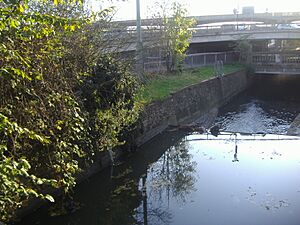
Hendon's highest point is about 85 meters (279 ft) around Church End, with other areas sloping downwards.
The River Brent flows through Hendon. In November 2009, the Environment Agency warned people about flooding along the River Brent in Hendon after heavy rain.
There are two large public parks: Hendon Park in the south and Sunny Hill Park in the north. Sunny Hill Park is separated by the A41 road from the Copthall sports complex.
 |
Colindale, Burnt Oak, Edgware | Mill Hill | Holders Hill, Finchley (Church End) |  |
| The Hyde, Kingsbury, Kenton | Temple Fortune, Hampstead Garden Suburb, East Finchley | |||
(The Burroughs/Watford Way) |
||||
| West Hendon, Kingsbury Green, Neasden, Wembley Park | Cricklewood, Dollis Hill, Willesden Green | Golders Green, Hampstead |
Who Lives in Hendon?
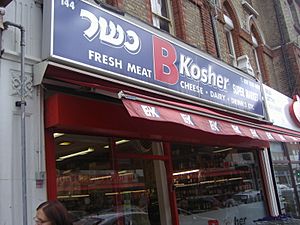
According to the 2011 census for the Hendon area, 60% of the people were white. The largest group was White British (35%), followed by other white groups (25%). Other groups included 17% Indian, 7% Black African, 5% Other Asian, and 4% Chinese. Hendon has a large Jewish population. The West Hendon area is even more diverse, with over half of its residents from minority ethnic backgrounds.
Getting Around Hendon
Hendon is served by Hendon Central tube station on the Edgware Branch of the Northern line (London Underground). It also has Hendon railway station on National Rail's Thameslink service.
Many minicab companies operate in Hendon. The main roads that pass through Hendon are the A1 (Great North Road) and the A41 (North Western Avenue), also known as Hendon Way and Watford Way. The A406 (North Circular Road) also goes through Hendon. The junction of the A41 and A406, called the Brent Cross flyover, is known for traffic.
Further north is the site of Hendon Aerodrome, now part of Colindale. It was famous for many aviation firsts, like the first airmail delivery and the first parachute jump from a powered aircraft. During World War II, RAF Hendon provided the first air defence for a city. It closed for flying in 1968 and is now home to the RAF Museum and new housing areas like Grahame Park and Beaufort Park.
Buses in Hendon
Many bus routes connect Brent Cross Shopping Centre to the West End of London and the new Wembley Stadium. Buses travel to various parts of London and beyond.
Learning in Hendon
Secondary schools in Hendon include Hendon School, Hasmonean School, and St Mary's and St John's CE School. Brampton College is a private college for older students. Hendon is also home to Middlesex University.
Local Government
The Hendon constituency is represented in the UK Parliament by Conservative MP Matthew Offord, who has held the seat since 2010.
Sports in Hendon
Hendon is the home of the rugby union club Saracens, who play at Copthall Stadium. Next to Saracens is Hendon RFC, the local amateur rugby club. The local football club is Hendon F.C.. Hendon also has a golf club and a leisure centre. The local ladies' hockey club is Hendon & Mill Hill Hockey Club.
Public Services
Hendon is patrolled by the Metropolitan Police, which is the police force for Greater London. The Shomrim London North West Community Patrol also helps with local safety. Colindale Police Station is nearby. Local National Health Service hospitals include Edgware Community Hospital and Finchley Memorial Hospital. Hendon Magistrates Court is located on The Hyde.
Famous People from Hendon
Many notable people have connections to Hendon, including:
- Zak Abel (born 1995) – a singer/songwriter and musician.
- Naomi Alderman – an author.
- David Bedford OBE – a former world record holder for the 10,000m race and former Race Director of the London Marathon.
- David Bohm – a physicist.
- Denis Compton – a famous cricketer and footballer.
- Sir Henry Cooper – a heavyweight boxer.
- Claude Grahame-White – a pioneer aviator.
- Graham Hill – a Formula One World Champion.
- Ruth Prawer Jhabvala – a novelist.
- Lord Mandelson – a Labour politician.
- Oliver Postgate – an animator, puppeteer, and writer.
- Thomas Tilling – who started an omnibus (bus) company, was born here in 1825.
- Lacey Turner – an actress known for playing Stacey Slater in EastEnders.
- Matty Healy – Musician and frontman of The 1975.
See also
 In Spanish: Hendon para niños
In Spanish: Hendon para niños
Images for kids
-
Hendon War Memorial on Watford Way
-
The River Brent in Hendon
-
A kosher shop in Hendon



